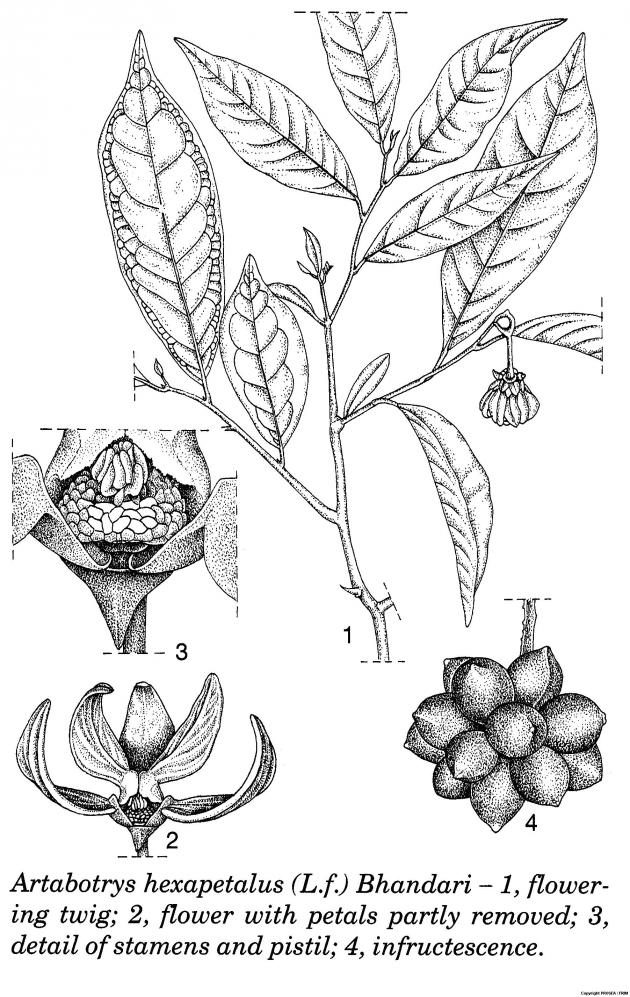Scientific Name
Artabotrys hexapetalus (L.f.) Bhandari
Synonyms
Annona hexapetala L.f., Annona uncinata Lam., Artabotrys hamatus (Dunal) Blume, Artabotrys intermedius Hassk., Artabotrys odoratissimus R.Br., Artabotrys odoratissimus Wight & Arn., Artabotrys uncata (Lour.) Baill., Artabotrys uncatus (Lour.) Baill., Artabotrys uncinatus (Lam.) Merr., Unona uncata (Lour.) Dunal, Unona uncinata (Lam.) Dunal, Uvaria esculenta Roxb. ex Rottler, Uvaria odoratissima Roxb., Uvaria uncata Lour. [1]
Vernacular Name
| Malaysia | Kenanga china, kenanga bolok [2] |
| English | Climbing ylang-ylang [2] |
| Thailand | Kradangngaa cheen (Central); sabanngaa cheen (Northern) [2] |
| Vietnam | D[aa]y c[oo]ng ch[us]a, hoa m[os]ng r[oof]ng [2]. |
Geographical Distributions
Artabotrys hexapetalus is indigenous in southern India and Sri Lanka but later introduced throughout the Old World tropics. Artabotrys can be found in dry thickets and secondary forests as well as moist primary forests in gaps. [2]
Botanical Description
A. hexapetalus comes from the family of Annonaceae. It is a climber or scandent shrub that can reach up to 8 m tall. Its young twigs are densely appressed and brown hairy while the old twigs are with many obtuse, thorny branches (hooked peduncles) of 1.5-6 cm long. [2]
The leaves measure 5-25 cm x 2.5-8 cm, wedge-shaped at base, acute at apex, short- acuminate and with 0.4-0.8 cm long petiole. [2]
The flower is solitary or in pairs on a straight peduncle but later thickened and recurved. The sepals are ovate-triangular, about 5 mm long and hairy outside. The outer petals measure 3.7-4.5 cm x 0.9-1.6 cm while the inner petals measure 3.2-4.2 cm x 0.9-1.2 cm, green turning bright yellow and with 20-30 carpels. The carpels are monocarp, obovoid, mucronate, 3.5-5 cm long, juicy, very fragrant and yellow. [2]
Cultivation
A. hexapetalus commonly cultivated in southern China, Indo-China, the Philippines and also in Java.
Chemical Constituent
No documentation
Plant Part Used
No documentation
Traditional Use
No documentation
Preclinical Data
No documentation
Clinical Data
No documentation
Poisonous Management
No documentation
Line Drawing

References
- The Plant List. Ver1.1. Artabotrys hexapetalus (L.f.) Bhandari [homepage on the Internet]. c2013 [updated 2012 Apr 18; cited 2015 Apr 07]. Available from: http://www.theplantlist.org/tpl1.1/record/kew-2653287
- Aguilar NO. Artabotrys hexapetalus (L.f.) Bhandari. In: van Valkenburg JLCH, Bunyapraphatsara N, editors. Plant Resources of South-East Asia No. 12(2): Medicinal and poisonous plants 2. Leiden, Netherlands: Backhuys Publisher; 2001. p. 88-89.


